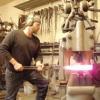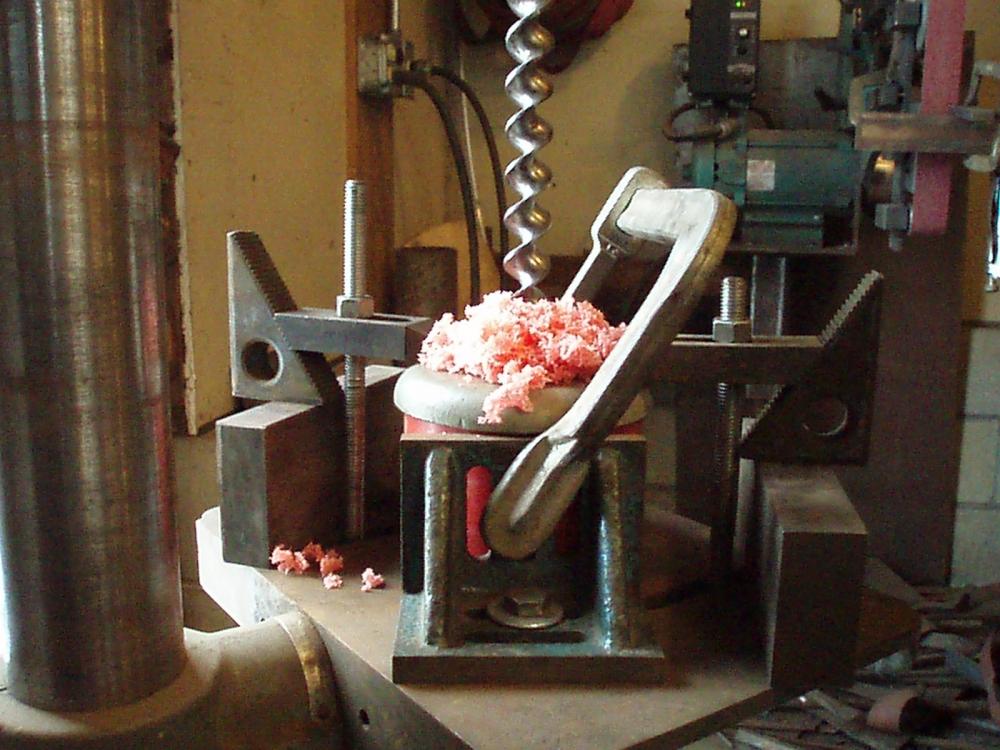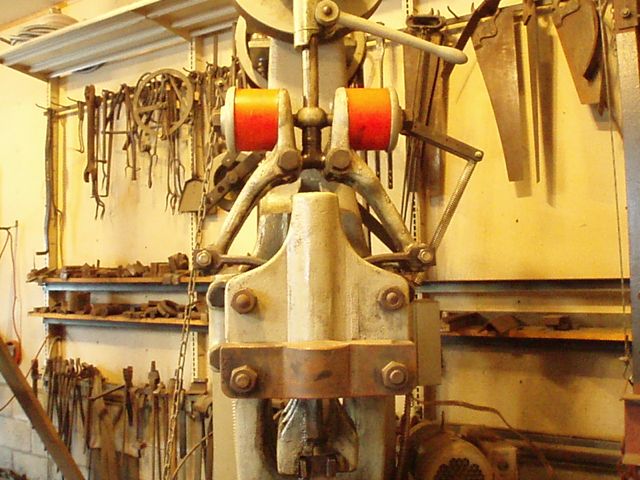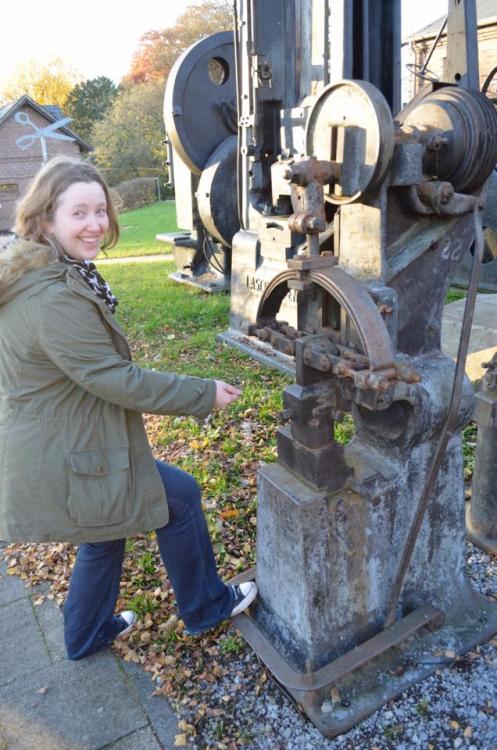-
Posts
166 -
Joined
-
Last visited
Content Type
Profiles
Forums
Articles
Gallery
Downloads
Events
Posts posted by Andrew T
-
-
Don't know the boss hammer, but, are you sure it's not cast iron on cast iron? Clutch material could be something like 1/4" leather that gets oiled for a nice slip but I don't see any holes for mounting it to your clutch.
-
Great looking hammer, is it not running right?
-
Caleb, I'm calling the clutch part with the headless bolt the "clutch spider" the part that spins freely the "clutch pulley". It seem that the pulley is free the rotate and slide, so nothing needs to be done to it. The spider is fixed to the shaft somehow, and needs to be loosened so the shaft can slide free of it. I can't tell how the headless bolt is acting on the spider/shaft, but I'm guessing that's the key. A quick call to LG might confirm a course of action.
-
Seems like you need to loosen the clutch assembly from the shaft. Then slide the shaft out, not pound it, with the crank plate attached. Isn't there a set screw on the clutch spider holding it to the shaft? I've never worked on that type of hammer, but I can't see how else it would be put together.
-
You can remove the brake while you test and tune the slack belt. My hammer runs beautifully with out a brake. That would remove one variable. Get the slack belt right, then do the brake. Just make sure you can hit the off switch quick in case it wants to run away.
-
Consider keeping the oil hole the way they are. I use my Stihl bar oil in a little oil can.
4 little shots on the 4 faces of the ram, 6 shots in the linkage oil holes, 1 for the crank pin, 2 for the main shaft, and 1 for the idler pulley.
It's easy and fast, I do it every time before I start it up.
-
You need 4 big wrenches to adjust this machine properly. The largest one is on the crank plate which adjusts the "throw" radius, I forged mine out of a piece of grader blade. You will need 2 to adjust the rear guide, and one more size for the rubber compression, which should also fit the anvil and front guide nuts. I didn't have any large wrenches until I got my hammer.
You want more compression on the rubbers, your hammer head is cycling erratically in your video, it jerks and flutters around. Judson is correct, the toggle arms should be closer to horizontal. Don't be afraid to play with the compression you can always set it back to where it was.
Who are you getting rubbers from? The ones Stewart G has are for a beam hammer, not a Compact.
-
Both vids are working for me. Yes I have a Bradley Compact, same as yours just smaller.
Try tightening the nuts on the left and right sides of the rubbers a 1/2 turn or more. This will put more compression on the rubbers and smooth out the action of the ram when running it faster and it will make it hit harder. I can see your rubbers are a bit loose in your 1st vid and the ram flutters and flops a bit when you pick up speed. Also if there isn't enough compression on the rubbers the top of the ram can get thrown up too high and contact the linkage, don't let that happen.
It looks like you're missing the middle bolt in the rectangle cut out in the frame. There are three bolts/jam nuts that adjust the tightness of the rear guide. Top and bottom bolts pull the guide away from the ram, the middle one pushes it in. There are also two more bolts on the side of the frame that clamp the guide in position after the adjustment is made.
Hope this makes sense, after you stare at it long enough you should be able to figure it out.
Here is a parts list and some basic info for your hammer
http://www.newenglandblacksmiths.org/bradley-compact/
Feel free to ask questions I gone over ever inch of my hammer and use it quite a bit.
-
I have a 100lber, I use a 2 ply leather belt with some kind of fabric glued in between the layers.
Works great no stretch haven't treated the leather for 10+ years still looks perfect.
A couple of tips
Keep your rear guide adjusted a tight as you can with out making the ram drag = less stress on the front guide while off centered hammering.
Keep the lever in the proper orientation so you can properly clamp the pitman. If the pitman slips out of the sleeve while forging you can break the sleeve casting.
In your video it looks like you could use more compression on your rubbers.
Do you have your anvil bolted tight to your frame? I use a piece of 1/2 plywood with saw kerfs 1" or so in between the hammer and anvil. You need a cushion in between.
Apologies if you know this already , just my experience with my hammer.
-
I believe they are 6"x8" on the face, I don't know how tall they are.
-
Variable speed.
Wire wheels, grinding and sanding discs so much nicer at low to medium speed.
Haven't touched my favorite Makitas since I got one.
-
Nice anvil block, what is it 10"x10" hot rolled? Who is your steel supplier?
-
Are your new ones rubber or urethane?
-
I had mine tested at a tire shop and I think they were in the low 60A range, I could double check my notes. There have been threads on this topic before with no real consensus.
I made new rubbers from 70A urethane and it seems a bit to hard. Others have mentioned higher hardness values.
-
I believe many fork tines are currently made from boron steel like 15b30/15b41. I made flat dies for a press with this steel and it seems to hold up ok so far.
I was able to band saw, drill and tap and use with no additional heat treat.
-
You will not get rubbers from Cortland, they sold that to Bruce Wallace, he is a bit touchy to deal with, I would guess that he has zero info on your hammer.
Make the mold or cut down Giesler's if they are big enough.Your vulcanizer can maybe test the hardness of your original rubbers. I used urethane rod and made rubbers for my Bradley, 70 duro seemed a bit hard.
-
Beaudry, I have the same issue with the dies on my Bradley. They are the original dies which are fairly soft. I think old school dies tend softer maybe worried about projectile cracking? I think 4x4x8 is to large in 4140 to get full hard. S7 or 4340 or some other higher alloy might yield harder dies safely. Big dies like that are an investment for sure. Nathan R. makes tooling plates the full size of his dies for the same scale reason.
I like the tool trays. You have a nice tight fit between your anvil and frame did you caulk it?
-
The right arm looks a little shorter than the left in your photo. Measure both and compare length to replacements from Little Giant.
-
I don't think you will ever get the arms to point uphill on a hammer without adjustable knuckles.
Beaudry does have a point about arm length, it might be worth your time to get some pin to pin measurements from similar machines. Call Little Giant again and ask.
I think Clifton Ralph said he did not like that style of spring tensioner or the single knuckle type, and favored converting to the two knuckle adjuster type. Although I'm not sure why your style wouldn't be fine if the spring fit.
I made new tee-toggles for a 50lber using long grade 5 bolts with the tee welded on, and welded knuckles from bushing stock. Ken Kern shows it in his Little Giant book, which I no longer have a copy of.
Longer arms might give you more throw/power as long as the ram doesn't hit the spring and knock it out into your face.
-
-
Ideally your toggle links would be both be longer. Then you could double nut them so they wouldn't loosen.
-
-
European high speed cutler's hammer like Pattinson.
https://www.iforgeiron.com/topic/40405-hattersley-and-davidson-power-hammer/
-
I think the guy that made those dies is a member here, uses them on a small self contained.





BOSS power hamer or something repair
in Power Hammers, Treadle Hammers, Olivers
Posted
Looks good, how did they attach the lining?